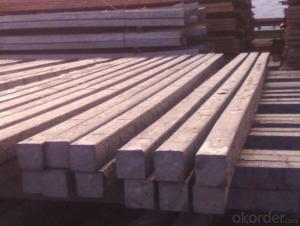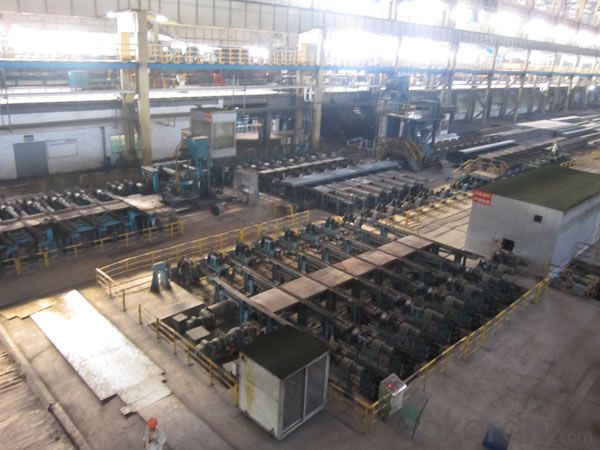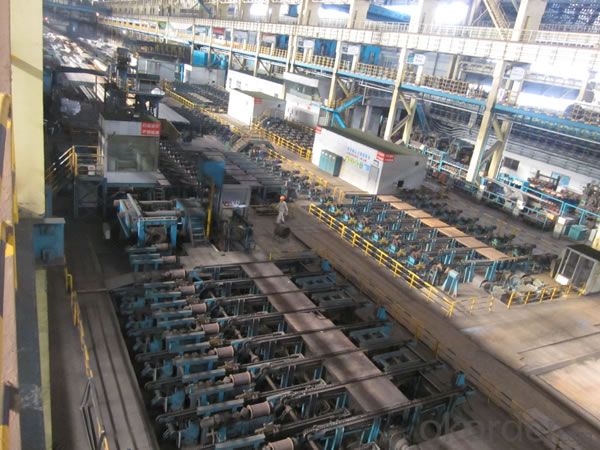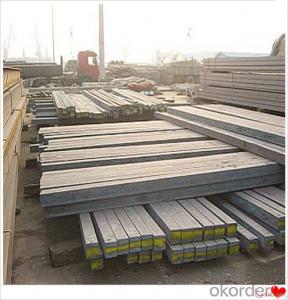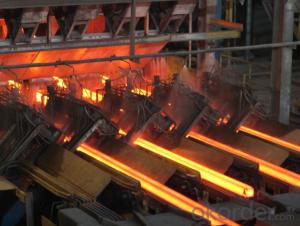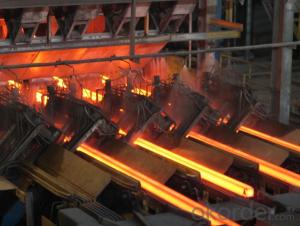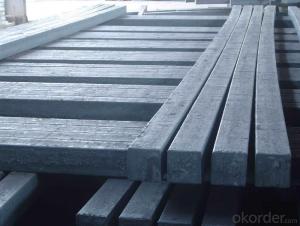Q235 3SP Square Steel Billet 105mm for Rebar
- Loading Port:
- Tianjin
- Payment Terms:
- TT OR LC
- Min Order Qty:
- 100 m.t.
- Supply Capability:
- 10000 m.t./month
OKorder Service Pledge
OKorder Financial Service
You Might Also Like
Description of Q235 3SP Square Steel Billet 105mm for Rebar
1. Prepainted steel coil is coated with organic layer, which provides higher anti-corrosion property and a longer lifespan than that of galvanized or galvalume steel sheets.
2. The base metals for prepainted steel coil consist of cold rolled, HDGI Steel, electro-galvanized and hot-dip alu-zinc coated steel. The finish coats of prepainted steel coil can be classified into groups as follows: polyester, silicon modified polyesters, polyvinylidene fluoride, high-durability polyester, etc.
3. The production process has evolved from one-coating-and-one-baking to double-coating-and-double-baking, and even three-coating-and-three-baking.
4. The color of the prepainted steel coil has a very wide selection, like orange, cream-colored, dark sky blue, sea blue, bright red, brick red, ivory white, porcelain blue, etc.
5. The prepainted steel coils can also be classified into groups by their surface textures, namely regular prepainted sheets, embossed sheets and printed sheets.

Main Feature of Q235 3SP Square Steel Billet 105mm for Rebar
Uncoated CR steel sheet
With the features of in line with the international highest standards in demension and shape, excellent surface finish and properties, the products are mainly used in home appliance and automobile industries.
Galvanized steel sheet(include HDG and EG)
With the features of good corrosion resistance, the products are mainly used in automobile, home appliance, electronics, building and machinery manufacture industries, etc.
Precoated steel sheet
With the features of enviromental protection and good processablility, long lasting surface durability, rich in colors, the products are maily used in building, home appliance and furniture industries, etc.
Applications of Q235 3SP Square Steel Billet 105mm for Rebar
A. Corrugated design makes it excellent waterproof performance
B. Materials as prepainted steel sheets, galvanized steel sheets, galvalume (Al-Zn coated sheets) are available to make corrugated sheet.
C.Those material are durable, anti-corrosion in bad weather for 20-30 years based on it's Zinc(Galvanized) coating or AZ (Galvalume) coating.
D. Different shape of the sheet make it suitable for any style of buildings.
E.Easy to install, no need special tools to fix the sheet.
F.Light weight due to high strength to weight ratio of steel. Light weight means easier handling lower shipping costs, easier installation
G. Different color is availbe base on the RAL Standard make your building more beautiful.
H. We will provide the best solutions if you don't have a exact idea of the specification you want for the steel sheet based on your weather conditions, engineering structure, construction budget and so on.
Specifications of Q235 3SP Square Steel Billet 105mm for Rebar
Product | Q235 3SP Square Steel Billet 105mm for Rebar |
Material Grade | SGCC / SGCH / DX51D+AZ, etc |
Thickness | 0.6-3.0mm |
Width | 500-1500mm |
Tolerance | Thickness: +/-0.02mm , Width:+/-2mm |
Zinc-coating | Z30-150g/m2 |
Technique | Raw material: Hot rolled steel coil --> Cold rolled_>hot dipped galvalume |
Surface | Dried, Chromated, Unoiled |
Spangle | Regular spangle , small spangle, zero spangle |
ID | 508MM 610MM |
Coil weight | 1-25MT |
Export package | Cardboard inner sleeves, Waterproof paper, galvanized steel covered and steel strip packed |

FAQ of Q235 3SP Square Steel Billet 105mm for Rebar
We have organized several common questions for our clients,may help you sincerely:
1. How Can I Visit There?
Our company is located in Tianjin City, China, near Beijing. You can fly to Tianjin Airport Directly. All our clients, from home or aboard, are warmly welcome to visit us!
2. How Can I Get Some Sample?
We are honored to offer you sample.
3. Why choose CNBM?
Our delivery time about 15-20days for standard sizes, if you have other requirements like hardness, quanity and width ,it is about 20-40days. But don't worry we also try our best for the delivery time ,because time longer and our cost is higher.
- Q: What are the main factors affecting the electrical conductivity of steel billets?
- The main factors affecting the electrical conductivity of steel billets are the composition and purity of the steel, the presence of impurities and alloying elements, the grain size and structure of the steel, and the temperature at which the billets are being processed.
- Q: What are the applications of steel billets in the automotive industry?
- Steel billets are an essential component in the automotive industry, playing a crucial role in various applications. One of the primary uses of steel billets in this industry is for the production of engine parts. The billets are forged and machined to create crankshafts, connecting rods, and camshafts, which are vital components for the proper functioning of an engine. Steel billets are also used in the manufacturing of suspension and steering components. These billets are shaped into various parts such as control arms, tie rods, and steering knuckles, which provide stability, control, and smooth handling to the vehicle. These components are crucial for ensuring a safe and comfortable driving experience. Furthermore, steel billets find applications in the production of transmission components. They are forged and machined to create gears, shafts, and other transmission parts that facilitate the smooth transfer of power from the engine to the wheels. These components play a significant role in the overall performance and efficiency of the vehicle. Additionally, steel billets are used in the manufacturing of chassis and frame components. By using billets, manufacturers can create strong and durable structures that provide stability and support to the entire vehicle. Chassis components such as cross members, brackets, and reinforcements are often made from steel billets to ensure the vehicle's structural integrity. In summary, steel billets are widely employed in the automotive industry for various applications. They are used to create engine parts, suspension and steering components, transmission parts, and chassis components. The use of steel billets in these applications ensures the durability, performance, and safety of vehicles.
- Q: Are steel billets used in the renewable energy sector?
- Yes, steel billets are used in the renewable energy sector. Steel is a versatile material that is used in the construction of various renewable energy infrastructure components. For example, steel billets are commonly used in the manufacturing of wind turbine towers, which are essential for the generation of wind energy. Steel billets provide the necessary strength and durability to support the enormous weight and withstand the harsh environmental conditions that wind turbines are exposed to. Additionally, steel billets are also utilized in the construction of solar power systems, such as solar panel mounting structures and support frames. These structures require a strong and reliable material like steel to ensure the stability and longevity of the solar panels. Therefore, steel billets play a crucial role in supporting and facilitating the growth of the renewable energy sector.
- Q: How are steel billets cut into smaller pieces?
- Steel billets are typically cut into smaller pieces through a process called sawing or shearing. There are various methods used to achieve this, depending on the desired size and precision of the cuts. One common method is using a saw blade, either circular or band saws, which are specifically designed for cutting through metal. These saws can be manually operated or automated, depending on the scale of the operation. The billets are clamped securely to prevent movement, and the saw blade is guided along the marked cutting line, gradually slicing through the steel to create smaller pieces. Another approach is shearing, which involves using a shear machine to apply intense force to cut through the billet. This method is often used for thicker billets or when precise cuts are not necessary. The shear machine consists of a fixed blade and a moving blade that come together to sever the billet along the desired cutting line. Additionally, advanced technologies like laser cutting or plasma cutting can also be employed to cut steel billets into smaller pieces. These methods utilize high-powered lasers or plasma jets to melt or vaporize the material along the cutting line, resulting in a clean and precise cut. Overall, the choice of cutting method depends on factors such as the thickness of the billet, the desired precision of the cuts, and the production capacity. Regardless of the method used, safety precautions are always taken to ensure the well-being of the operators and to maintain the quality of the cut steel pieces.
- Q: What are the specifications for stainless steel billets used in the food industry?
- To ensure safety and hygiene, the food industry requires stainless steel billets to meet specific specifications. These specifications focus on the stainless steel's composition, corrosion resistance, and ability to withstand high temperatures and aggressive cleaning agents. First and foremost, stainless steel used for food industry billets must contain a high percentage of chromium, typically ranging from 16% to 18%. This high chromium content ensures excellent corrosion resistance, preventing any reaction with food or cleaning agents. In addition, these billets should have a low carbon content, usually below 0.08%. By keeping the carbon content low, the stainless steel becomes less susceptible to sensitization, which can cause corrosion and contamination of food products. Furthermore, the stainless steel billets must adhere to specific international standards, such as ASTM A276 or EN 10088. These standards outline the minimum requirements for chemical composition, mechanical properties, and surface finish. Moreover, the surface finish of the billets is crucial in the food industry. It must be smooth and free from defects like pits or cracks to prevent the accumulation of bacteria and facilitate easy cleaning. The dimensions of the billets also contribute to their suitability for the food industry. They are commonly available in square or rectangular shapes, with various sizes depending on the specific application. Lastly, these billets should be certified and compliant with industry regulations, such as those set by the Food and Drug Administration (FDA) or the European Food Safety Authority (EFSA). In conclusion, stainless steel billets used in the food industry must meet specific requirements regarding chromium and carbon content, international standards, surface finish, dimensions, and industry regulations for safety and hygiene.
- Q: How do steel billets differ from steel bars?
- Steel billets and steel bars are both intermediate steel products that are used in various industries for further processing. However, there are some key differences between the two. 1. Shape: Steel billets are typically square or rectangular in shape, with cross-sectional dimensions ranging from a few inches to several feet. They are typically produced through continuous casting or hot rolling processes. On the other hand, steel bars are cylindrical in shape and have a uniform diameter throughout their length. They are usually produced through hot rolling or cold drawing processes. 2. Size: Steel billets are larger in size compared to steel bars. Billets can have lengths ranging from a few feet to several meters, while their cross-sectional dimensions can be customized based on the requirements of the final product. Steel bars, on the other hand, are typically produced in standardized sizes and lengths, such as 6 meters or 12 meters, and have a consistent diameter. 3. Production process: Steel billets are usually produced through continuous casting or hot rolling processes. Continuous casting involves pouring molten steel into a mold to form a solid billet, while hot rolling involves passing the billet through a series of rollers to reduce its cross-sectional dimensions. Steel bars, on the other hand, are produced through hot rolling or cold drawing processes. Hot rolling involves passing billets through a series of rollers to give them the desired shape and size, while cold drawing involves pulling the hot rolled bars through a die to further reduce their diameter and improve their surface finish. 4. Applications: Steel billets are primarily used as raw material for further processing into various steel products, such as bars, rods, wires, and tubes. They are also utilized in the forging industry to produce forged components. Steel bars, on the other hand, are used in a wide range of applications, including construction, manufacturing, infrastructure, and automotive industries. They are commonly used as reinforcement in concrete structures, as well as for the production of shafts, gears, axles, and other machine parts. In summary, steel billets and steel bars differ in terms of shape, size, production process, and applications. While billets are larger and have a square or rectangular shape, bars are cylindrical and have a consistent diameter. Billets serve as raw material for further processing, while bars are used in various industries for their specific applications.
- Q: How are steel billets used in the manufacturing of renewable energy equipment?
- Steel billets are used in the manufacturing of renewable energy equipment as a primary raw material. These billets are shaped and processed to create various components such as wind turbine towers, solar panel frames, and hydroelectric power structures. The strong and durable nature of steel allows for the construction of robust and long-lasting renewable energy equipment, ensuring their reliability and performance in harnessing sustainable energy sources.
- Q: How are steel billets used in the manufacturing of tools?
- Steel billets are used in the manufacturing of tools as the starting material. They are heated, shaped, and machined into various tool components, such as cutting blades, drill bits, or molds, to achieve the desired shape and strength.
- Q: Can steel billets be used for making hand tools?
- Hand tools can be made using steel billets. Steel billets are semi-finished steel products that are commonly used for further processing and shaping into different forms. Steel billets can be used to manufacture various hand tools such as wrenches, pliers, hammers, screwdrivers, and many others. Steel is a popular choice for manufacturing hand tools because of its strength, durability, and resistance to wear and tear. Steel billets can be forged, machined, or heat-treated to achieve the desired shape, size, and hardness required for hand tools. The versatility of steel allows it to be easily molded into different tool designs, providing the necessary strength and functionality. Moreover, steel hand tools offer several advantages over tools made from other materials. The high tensile strength of steel ensures that the tools can withstand significant force and pressure without breaking or deforming. Additionally, steel tools are resistant to corrosion and rust, making them suitable for both indoor and outdoor use, even in harsh environments. In conclusion, steel billets are indeed suitable for manufacturing hand tools. The strength, durability, and versatility of steel make it an excellent material for producing a wide range of hand tools that can endure heavy usage and provide long-lasting performance.
- Q: What are the different types of heat treatment processes used for steel billets?
- There are several different types of heat treatment processes used for steel billets. Some commonly used methods include annealing, normalizing, quenching and tempering, and case hardening. Each process has its own purpose and is used to achieve specific properties in the steel billets.
Send your message to us
Q235 3SP Square Steel Billet 105mm for Rebar
- Loading Port:
- Tianjin
- Payment Terms:
- TT OR LC
- Min Order Qty:
- 100 m.t.
- Supply Capability:
- 10000 m.t./month
OKorder Service Pledge
OKorder Financial Service
Similar products
Hot products
Hot Searches
Related keywords
